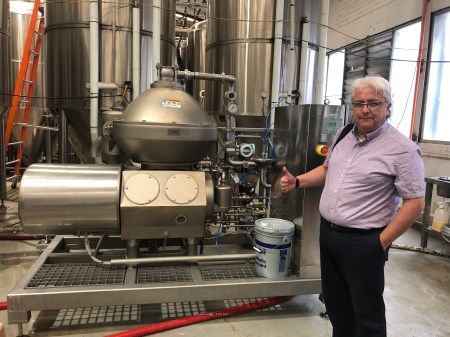Twin trends in craft brewing have helped to drive new innovations in the world of equipment manufacture across the globe.
Premiumisation within the craft beer category has led to brewers seeking ways to increase and guarantee the quality of their produce, while the desire for more variety has led to ever more outlandish ingredients being added during the brewing process.
These two trends have seen more brewers across the world bringing centrifugal technology into their breweries, but they have also resulted in further improvements and innovations with the centrifugal world itself.
A centrifuge is an additional filtration option for breweries that works in a complementary but fundamentally different way to standard filtration. In standard filtration, particles are removed from the beer depending on their size – in short, larger particles don’t fit through the mesh. In centrifugal filtration, the separation comes via “the differences between the weight or density of the particle”, according to Fernando Jimenez, an expert in centrifugal technology.
“In the majority of cases, centrifugation and filtration go along together,” he adds. “In centrifugation you can remove the majority of the particles: heavier particles, core solids, hops, yeast tails and other core solids, pieces of fruit, fruit peel and all that. But there are lighter components like proteins or polyphenols leading to Colloidal Haze. They are far more difficult to remove in a separator and for that purpose, filtration will do better.”
Jimenez was in Australia for the 36th Convention of The Institute of Brewing and Distilling, which was held in Perth from 16 to 20 March 2020, an event where centrifugal manufacturer Alfa Laval was showcasing its latest product: the Brew series of centrifuges.
The usage of centrifuges in brewing has been a growing trend globally, as the world’s craft beer movements, led by the USA, seek to forge their own paths in creative and premium craft beers.

Brew 250 in Australia
Jimenez cites Australia, France, Italy, Spain, China, Scandinavia and India among the regions where craft beer is growing dynamically, with every brewer trying to stand out.
“Everyone is trying to enter the premium and super premium category, and everyone wants a unique recipe, with different ingredients, unique ingredients, unique flavours,” he explains. “If you make premium products, you make better margins. Everyone’s chasing the next bestseller. If you want to enter with a premium product, the centrifuge is a technology that is really going to help brewers to deliver consistent quality in its products to consumers again and again.”
The assurance of consistent products is a major reason for bringing a centrifuge into the brewing process, but perhaps the most convincing is the increase of beer yields – a clear essential in an industry where every drop of beer recovered goes to the bottom line of the business. Wastage is reduced because a centrifuge can dehydrate solids further, meaning that less beer is thrown away.
“When there is no centrifuge in a given site, during preparation of one batch, normally you end up with beer in the bottom of the cone or in the bottom of the tanks with a fairly high amount of solids,” explains Jimenez. “Total beer losses generally could go from 5% up to 20%. Those losses are mainly produced when you dump the bottom of the cone which typically contains 50% beer.
“When you have centrifuge technology, instead of dumping bottoms – half of which is beer – to the drain, you will be able to recover up to two thirds of valuable beer which otherwise will go to the drain, increasing beer yields in the process by up to 10-15%. The technology helps the brewer to recover beer and ultimately to recover money because that is product that that will go to the bright beer tank and the packaging line not the drain.”
These estimations are dependent on the amount of dry hopping and other ingredients that has occurred in the process.
Given that this is a growing trend, as is the desire to add ever more outlandish ingredients to recipes and to brew a wider range of recipes, the centrifuge industry has adapted its machinery to be more flexible.
“The technology is definitely evolving,” says Jimenez. “Now you see far more non-traditional ingredients, like coffee, orange, raspberries, lemon, coriander, even wasabi; ingredients that in the past were never part of the brewing process.
“This trend is forcing the separator industry to design systems to endure under harsh clarification conditions and that are sufficiently flexible to cope with these changes in ingredients and demands in production. Modern separation systems should also be able to change recipes quickly, to produce beers of different styles using the same hardware and to run short batches with minimum disruption of the production line, and all that together with delivering a premium product with the right quality.
“Modern separation systems have more capabilities to deal with different recipes and additional functionalities in software to ease the operation by brewers. Mechanically they have higher standards to deal with more solids and often abrasive ingredients. Centrifuge manufacturers have evolved together with the industry because the market is changing their priorities and suppliers should cope with those needs.”
Given that centrifuges are already meeting a demand from brewers to bolster the quality, consistency and overall volume of their finished products, it looks like the industry will soon also be able to provide the necessary equipment to maintain those qualities regardless of how adventurous the brewing industry gets.
To find out more, click here.

